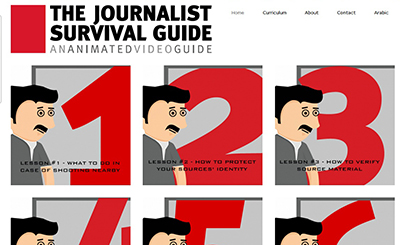A new English/Arabic online tool is available for citizen journalists who have no previous journalism experience or training but are reporting dangerous frontline stories. It uses animation–a novelty for such guides–and its arrival is timely.
With 17 journalists killed in Syria this year, most of them citizen journalists, that country ranks as the most dangerous place in the world to work. This week’s reports that the Syrian regime may have used chemical weapons, killing hundreds on the outskirts of Damascus, only underscore the risks. And in Egypt, at least eight journalists have been killed since pro-democracy uprisings swept the region starting in 2011. Five of them were killed in the past two months, amid the protests and violence related to the ouster of former President Mohamed Morsi.
The “Journalist Survival Guide,” produced and released earlier this month by the Beirut-based SKeyes Center for Media and Cultural Freedom of the Samir Kassir Foundation, is available in both Arabic and English to help citizen journalists as well as professionals. The foundation is named after a Lebanese journalist murdered in a car bomb attack in East Beirut in 2005.
Animation requires lower bandwidth to view than video, making the guide more accessible in places like Syria, where Internet connections are limited. Use of animation also helps overcome language barriers. A written summary of each of the guide’s nine lessons is available for download in English and Arabic.
The guide provides invaluable tips, such as recognizing the difference between hiding from view and being protected from gunfire; knowing how a source’s profile, even if video-recorded only in shadows, could still be identified; being aware of the digital markers or metadata in electronically transmitted information; protecting yourself from tear gas, and what you should do if you are exposed; and helping make your Internet connection more secure.
The lesson on “How to protect your computer against hacking and malware” is excellent. So is the lesson on “How to secure your Skype account.” Both address serious threats. Groups like the Citizens Lab, of Toronto, and the Electronic Frontier Foundation, of San Francisco, have uncovered the use of spyware embedded into what look like videos online of human rights abuses in Syria. The videos, however, end up downloading a cheap, Russian-made spyware called “BlackShades Remote Controller” that gives an attacker full access to a journalist’s computer, along with all of his or her information and contacts.
There are some shortcomings in the new guide. It sometimes tries to cover too much ground. The second lesson on “How to protect your sources’ identity” begins by explaining the ethics of interacting with individual sources before introducing, but only glossing over, the basic steps of digital security to protect not only sources but also information and the journalists themselves.
The section titled “What are your international rights?” is an accurate summation of international norms and laws, yet the guide fails to suggest how to handle situations when those rights are violated. Some topics are simply not well suited for an online guide, including the lesson on “the most important first-aid practices.”
There are many other sources available to address the gaps in this innovative new guide. The Brussels-based International Federation of Journalists provides the Live News Survival Guide. The London-based Institute for War & Peace Reporting offers a Training Manual. The Paris-based Reporters without Borders posts a Handbook for Journalists.
In the digital realm, the U.S.-based Internews has put out SpeakSafe: Media Workers’ Toolkit for Safer Online and Mobile Practices. The Berlin-based Tactical Technology Collective and the Dublin-based Front Line offer a thorough Security in-a-box: Tools and tactics for your digital security. Small World News offers a Guide to Safely Using Satphones.
CPJ’s own Journalist Security Guide is available in Arabic, Spanish, French, Somali and English, with more languages to be available later this year. It includes comprehensive chapters on such subjects as Assessing and Responding to Risk, Information Security, Armed Conflict and Stress Reactions.
Resources to produce SKeyes Center’s animated guide were provided by the U.S.-funded National Endowment for Democracy. The content of the project was prepared with the assistance of the Washington-based National Democratic Institute, the Lebanese Red Cross and the Global Center for Journalism and Democracy at Sam Houston State University in Texas.
“The lessons in the guide are not only aimed at journalists on the ground but also media specialists, photographers, video editors, activists and others who find themselves in dangerous conflict zones,” according to a statement by the SKeyes Center on Aug. 5, when the guide was launched.
